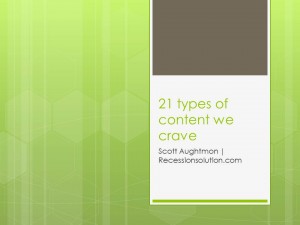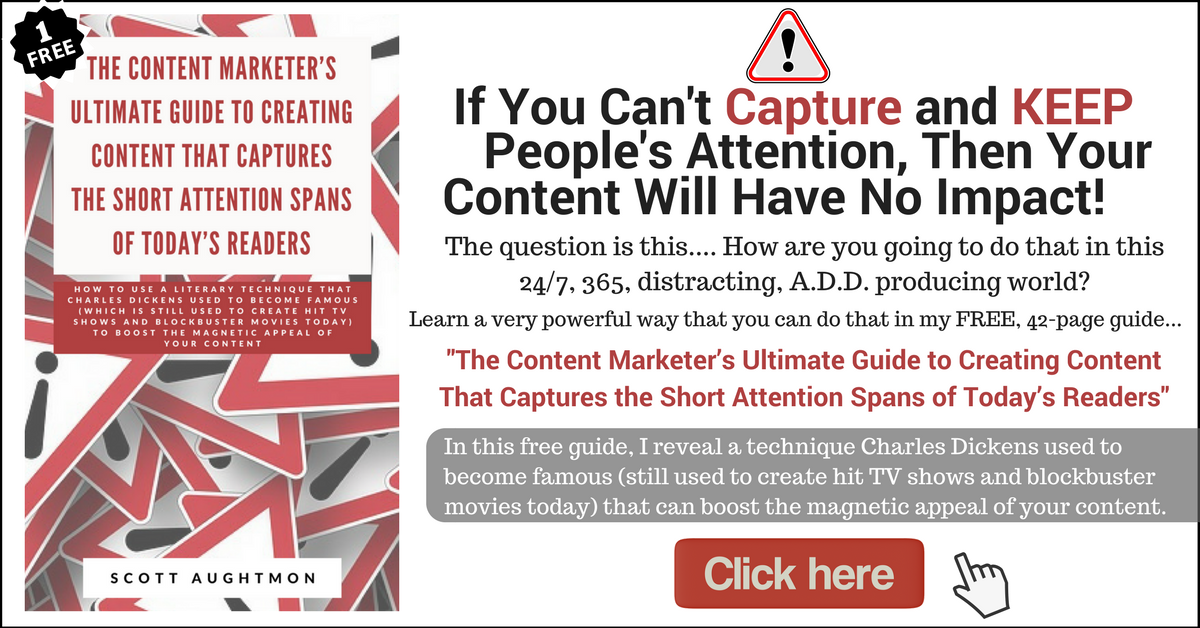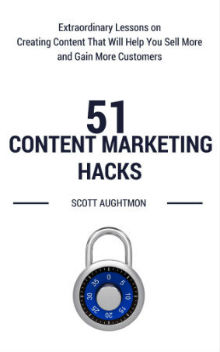This is an important post I put up last year. I thought those of you who missed it the first time should see it now…
It’s ok. Go ahead. Call me a “sap.” I probably deserve it.
Why? Well, there is a local radio station that begins playing Christmas songs 24/7 starting on December 1st and plays them every day up until, and including, Christmas day.
And the reason you might want to call me a “sap”?
I really like listening to the station during this time of year. I don’t why. I just don’t get sick of hearing those songs. Maybe it’s the feeling I get from hearing those songs.
But I was listening to the station the other day enjoying the old school classic Christmas songs I know (i.e. White Christmas, I Saw Mommy Kissing Santa Claus, Silent Night, etc.), and being in awe of how many Christmas songs that I’ve never heard of (98 degrees had a Christmas song?), when I realized something.
There are some important content marketing lessons to learn from Christmas songs.
(Did you just hear that ”someone-bumped-the-turntable-needle-scratch-now-there’s-silence” sound?)
Are you wondering if I’ve had a little too much spiked egg nog? I haven’t. I’m serious. There are some important content marketing lessons that we can learn from Christmas songs.
Think about it. Why else would so many top artists do Christmas songs? Here are the content marketing lessons I’ve learned from Christmas songs.
1. If you want your prospects’ attention, then produce content based on things they are already thinking about.
Famous “old school” marketer Robert Collier revealed this concept back in 1934 in his book, The Robert Collier Letter Book:“Join the conversation already going on in your prospects’ mind.”
Everyones’ mind is on Christmas this time of the year, so the smartest thing for singers is to sing songs that focus on this theme.
This will get them attention from prospects, media outlets, and other avenues because of their focus on this theme.
Your First Lesson:
Create content around themes that everyone is focusing on throughout the year. Ex. January = Goals & resolutions, February = Love, March = Luck, April = Fooling people, etc. This will gain you attention and traction that you otherwise would never get.
2. Try and create content around certain themes that have an enduring and universal appeal.
Not only is it wise for singers to sing Christmas-themed songs so that they will get attention this year, but so they will get attention (and sales) for years to come.
Puerto Rican singer-songwriter José Feliciano may not be a top-selling singer nowadays, but every year one of the Christmas songs that is guaranteed to be played is “Feliz Navidad“, a Christmas song he wrote back in 1970.
I don’t know what kind of kind of royalty deal he has, but that song brings him continual exposure and, hopefully, continual profits for him. It keeps him in demand.
Your second lesson:
Create your content around universal themes that will be appealing to your prospects today and 30 years from now.
Focus on themes such as: good vs evil, rags to riches, darkness vs light, David vs. Goliath, and many others.
If you can tie your content (and your product/service) to one of these themes, then you will see lasting, continual results. Apple tied their story into the “David vs. Goliath” theme and we’ve all seen the results they had!
3. Finding the current or lasting theme is the key thing.
After you do that, you have many options to choose how you actually produce the content. Christmas songs teach you three basic methods that you can use to produce the content.
The first choice is what some singers do. They sing a classic song like “O Holy Night.” It’s a public domain song.
They don’t have to pay for it or share royalties. It’s guaranteed to be popular and have a strong emotional pull. All they have to do is put their own twist on it and its ready to go.
The second choice is what other singers do. They license a song that has already been created.
I’m betting they have to pay a fee upfront and/or pay a certain percentage of any income they make from it.
Why would they do that? They don’t care.
Again using a song that was already written and proven to be popular basically guarantees them exposure and sales. Plus the song is getting that singer exposure and selling their real product, which is them.
But there is a third choice that some singers bravely choose to do. They create a brand new song around the Christmas theme.
This is riskier, because it might not be as popular as a song which has already been written and proven popular.
But I would think it wouldn’t be as risky as a normal song they would write. Why? It’s guaranteed to at least get some exposure and attention, because it’s tied to this powerful theme.
And if it’s a hit, then it will be a song that will be played for years to come and bring them future exposure and profits.
Profits they won’t have to share as they would if they licensed a song. And, as a bonus, it might become so popular that singers in the future will pay them money to license it to sing themselves.
Your third lesson:
Once you find the current or universal theme that will appeal to your prospect, then choose the method you will use to create the content:
1. Create the content yourself
2. License the content
3. Use public domain content.
If you pick a truly powerful theme, then creating the content is the easy part, since you have these 3 options.
One last thing.
If you aren’t sure you can really apply this idea to the content you create, let me ask you if you noticed something.
Do you see what I just did in this post? I created content (about content marketing) and tied it to a theme that is on your mind right now (Christmas)!
And because I did this, you read this post.
See? If I can do that with the topic of content marketing, then you can do it too.
Photo by Paparutzi.
Do you want to learn how
to create content like this?
Then check out…








